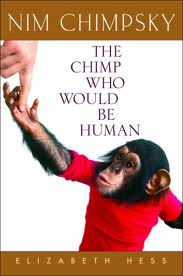The story of Project Nim, recently popularized by a documentary of the same name, begins with a chimp whose mother is tranquilized so that scientists can take the screaming newborn to a new, human, surrogate mother. The goal is to answer the question: can a chimp learn language?
 The experiment was influenced by the theories of American behaviorist B.F. Skinner, who subscribed to a theory called ‘radical behaviorism.’ Put simply, he believed that language was a learned behavior, and that even animals, if given the right environment, could learn language. As the animals thought to be the most similar to humans, chimps would seem to be the ideal species to cross the language barrier, if any animal could. The foremost opponent of this ideology is Noam Chomsky (Nim Chimpsky is an obvious play on his name), who argues that language is uniquely and innately human.
The experiment was influenced by the theories of American behaviorist B.F. Skinner, who subscribed to a theory called ‘radical behaviorism.’ Put simply, he believed that language was a learned behavior, and that even animals, if given the right environment, could learn language. As the animals thought to be the most similar to humans, chimps would seem to be the ideal species to cross the language barrier, if any animal could. The foremost opponent of this ideology is Noam Chomsky (Nim Chimpsky is an obvious play on his name), who argues that language is uniquely and innately human.
From the beginning, the project had serious shortcomings as a scientific experiment as well as the obvious evolutionary overtones, that chimps might be capable of such things due to being our alleged closest ancestors. Herbert Terrace, the leader of the experiment, entrusted Nim to a series of female graduate students, and with two of whom he admitted to affairs (though he was quick to defend his actions in both cases by saying that the science of the project wasn’t affected).
The project
Nim went to live with his first surrogate family when he was only two weeks old. Stephanie Lafarge and her husband Wer, with 7 kids between them, were ‘rich hippies’ in New York (this was the 70’s after all!). Stephanie said she was in love with Nim from the moment she laid eyes on him (and given the adorable photos and archival footage intertwined with the interview, the viewer can see why). However, neither she nor anyone in her family knew anything about chimp behavior or teaching sign language. Stephanie and Wer didn’t even discipline their own human children, and they had no inclination to do anything differently with Nim. He was allowed to run rampant. From the beginning Nim didn’t like Wer and took measures to come between Stephanie and her husband. Chimps by instinct try to assert dominance over males, especially those they perceive as weak.
Humans breastfeeding chimps?
LaFarge breast-fed Nim for several months, which she said “seemed completely normal”. She also admits to giving him beer and marijuana (the first of at least two of his caretakers to get the chimp high). She even admitted feeling attracted to him, though she said that it would be unthinkable to act on it, since he was ‘like a pre-teen’. She said there was ‘nothing passive’ about him—he loved to explore his environment, he loved fast cars and anything thrilling.
Despite this decidedly dysfunctional and sickening environment, Nim began to learn signs at a rate which far exceeded anyone’s expectations. This included signs based on ASL (American Sign Language) as well as some that Nim created himself (which were counted as true signs as long as he used them consistently). But this progress was not being recorded in any journals or logbooks. There were no lesson plans, no data collecting at all. Terrace brought in a new research assistant, 18-year-old Laura Ann Petito, who initially babysat Nim and taught him signs, and eventually became his new surrogate mother when the project moved to the spacious Delafield estate in the Riverdale section of the Bronx.
The researchers were excited when Nim began to spontaneously put signs together, making short phrases such as ‘Tickle Nim’. Surely, they thought, this was evidence of emerging language. His continued progress and growing vocabulary seemed to justify their optimism, and the project gained media attention.
Joyce Butler and Bill Tyler joined the project as Nim’s teachers (in reality, there were dozens of people involved in Project Nim, but the documentary only featured a select few who were the primary teachers). Joyce became Nim’s surrogate mother after Laura left in the messy aftermath of an affair with Terrace (which again, he claims did not affect the science of the experiment).
Problems controlling Nim
The interviewees tend to anthropomorphize Nim to various extents, but there are definite signs that Nim is very much a chimpanzee, and the documentary doesn’t shy away from his chimp nature. His dislike of most males (the project consisted of mostly females), especially those who seemed weak, and his tendency toward violence in certain situations were only a few challenges. LaFarge said that she “wasn’t prepared for the wild animal in him” and another teacher expressed that it was impossible to give human love to an animal that could potentially kill you. Nim’s eye teeth were never removed, making him that much more dangerous (one teacher noted that he essentially had fangs). That teacher left Project Nim after he bit her face leaving her with a gruesome injury (we see a particularly graphic reenactment of the aftermath). Those who didn’t understand that, as one person in the documentary put it, “the reality is it’s not a doll, it’s not a toy, it’s not a human—it’s a chimp” usually ended up with scars as a testament to their naivety.
Terrace, who is portrayed perhaps not undeservingly as the ‘villain’ of the story, ended the project in 1977. He explained in the documentary that “no one keeps a chimp for more than five years”. He was sent back to the institute where he was born, where Bob Ingersoll befriended him (his first ‘buddy’ who actually knew something about chimp behavior), and became an advocate for Nim until the chimp’s death in 2000 at the age of 26.
Was Project Nim a success?
After the study concluded, there were reams of data that had yet to be analyzed. During the study, the general feeling was that Nim was in fact learning language. But Herbert Terrace came out with the bombshell findings that Nim never actually demonstrated the ability to use true language, instead arguing that he learned that certain arbitrary signs resulted in rewards, but never figured out the grammar necessary for calling it language.1
It is reasonable to assume that a wide range of animals can communicate with each other on some level. However, as humans we have great difficulty in deciphering animal language codes. However, we can understand many animal behaviours or actions like the growling of a dog, which we know is a warning sign to us. Similarly, we can instruct animals to obey certain commands given by us. Such things occur due to recognition and the created abilities given to both us and animals. We know that many animals have the capacity for building a vocabulary of up to hundreds of words—whether those ‘words’ take the form of a spoken command understood by the animal as in training dogs, a modified ASL as has been used in chimp, orangutan, and gorilla language studies, or certain nonsense symbols in ‘Yerkish’. In each case, an arbitrary symbol or set of phonemes stands for a specific concept that is understood consistently. Chimps fall in the ‘mid range’ as far as their ability to learn vocabulary—some birds perform more impressively, even though chimps are supposed to be far more closely related to humans. This overriding assumption clouded the judgment of the participants to start with, because it focused on the morphology of such apes and their resemblance to humans. But the capacity of parrots, for example, to exceed chimpanzee’s performance in this area showed created design elements of the creatures more than any supposed similarities due to ancestry.
It doesn’t matter how much vocabulary an animal learns, because the key to language is grammar. A child picks up sentence structure spontaneously. For instance, he may hear a sentence such as ‘Bill hit Jim’, but from that he is able to extrapolate other sentences such as ‘Jim hit Bill,’ ‘I picked up the bat’ and others requiring more than hearing and parroting phrases. In other words, children do not learn sentences—even very young children use complicated grammatical rules to put together sentences that they have never heard before. One school of linguistics argues that even the grammatical rules are not so much learned as developed as a result of an innate human ability to learn language. As a child grows, provided he is surrounded by other people using language, he will naturally learn the grammar of the language and gain the ability to construct increasingly complicated sentences.
Nim and other animals have never demonstrated this ability. The average length of Nim’s utterances never increased. Furthermore, they were nearly always in response to prompting—nearly 90% of his signs were a response to his teachers, and up to 50% of them were mimicking his teachers’ statements. Furthermore, children, even in the earliest stages of learning language, show understanding of turn-taking in conversation—one party speaks, and the other answers, each adding information. Nim never showed this elementary understanding, instead interrupting his teachers. Terrace hypothesized that Nim understood the faster he gave the desired signs, the faster he got his reward.2
Evolutionary assumptions
Evolution isn’t highlighted per se in the documentary, but the whole project, and the unstated thinking about chimps in general, was bathed in evolutionary assumptions. Of course, the most obvious is that there is little or no qualitative difference between animals and humans—that language in particular is a skill that any higher animal could learn. Chimps were thought to be one of the most likely candidates because most people (based on evolutionary assumptions) think they are our closest relatives.
It is noted that chimpanzees are often used in researching vaccines (as Nim was for a while) because their physiology is so similar to that of humans. But the similar physiology could be explained as the result of a common designer (Romans 1:20).
Several times the interviewees talk about Nim’s ‘human side’, and invest him with decidedly human characteristics such as forgiveness. Much of this is along the lines of how one might talk about a beloved pet, and perhaps shouldn’t be taken too seriously.
Could chimps ever learn language?
Despite the failure of Project Nim to show that a chimp could learn a language, Terrace didn’t claim that the experiment proved that chimps couldn’t learn language. Perhaps the methodology was flawed in such a way that prevented Nim from achieving his full linguistic potential, for example.
Noam Chomsky said of attempts to teach various apes sign language:
“It’s an insult to chimpanzee intelligence to consider this their means of communication. It’s rather as if humans were taught to mimic some aspects of the waggle dance of bees and researchers were to say, ‘Wow, we’ve taught humans to communicate.’”3
He also points out that if apes were to learn language in any true sense of the word, it would be a tremendous problem for biologists: namely, why would apes have this dormant ability never expressed innately, waiting for humans to come along and teach them how to use it? Chomsky says, “It’s as if humans can really fly, but won’t know it until some trainer comes along to teach them.”4
Regarding claims that chimps can sign just about as well as children first learning sign language, so if the children’s signs are considered language then so should the chimps’, Chomsky says, “That’s about like saying that Olympic high jumpers fly better than young birds who’ve just come out of the egg—or than most chickens. These are not serious comparisons.”5
Specifically regarding Project Nim, Chomsky remarked:
“Interesting story about poor Nim. The experiment was carried out by a very serious experimental psychologist, Herbert Terrace. A convinced Skinnerian [student of Behaviorist, B.F Skinner], he expected that if an ape was brought up just like a human it would be a little human. … The experimentation was done with meticulous care. There’s a book, called Nim, which describes it, with great enthusiasm, claiming at the end that it was a grand success and the ape is ready to go on to great things. Then comes the epilogue. When the experiment was over, a grad student working on a thesis did a frame-by-frame analysis of the training, and found that the ape was no dope. If he wanted a banana, he’d produce a sequence of irrelevant signs and throw in the sign for banana randomly, figuring that he’d brainwashed the experimenters sufficiently so that they’d think he was saying “give me a banana.” And he was able to pick out subtle motions by which the experimenters indicated what they’d hope he’d do. Final result? Exactly what any sane biologist would have assumed: zero.”6
Chimps: amazing created creatures
Project Nim, as well as other chimp language studies, show that chimps are intelligent creatures that can understand far more at times than their human trainers anticipate or give them credit for. If we view them as furry humans, they are incredibly deficient. But when viewed as animals, yet endowed with the capacities their Creator intended, we can appreciate their delightful cleverness in understanding what behaviors will result in the correct reward—for what it is. They even show a certain capacity for manipulating their trainers.
An aside
Bioethicists like Peter Singer have advocated ‘human’ rights for apes, while at the same time proposing infanticide—that ‘unwanted’ human children could be killed up to 28 days after birth (sadly, even President Obama refused to vote for a law that would require that babies born as a result of an attempted abortion be given proper medical care). In essence, this is because he has downgraded the status of humans rather than elevate that of the apes. However, the Nim experiment shows clearly that his claims have no scientific basis. Apes are created to do what apes do, and human capacities far exceed any of the ‘smartest’ animals. This is because human beings are made in the image of their Creator and endowed with some aspects of His nature.
Related articles
Further reading
References
- H Terrace, ‘How Nim Chimpsky changed my mind’, Psychology Today 13(6): 67–72. Return to text.
- Terrace, p. 71. Return to text.
- “On the Myth of Ape Language: Noam Chomsky interviewed by Matt Aames Cucchiaro”, available online at chomsky.info. Return to text.
- Ref. 3. Return to text.
- Ref. 3. Return to text.
- Ref. 3. Return to text.




